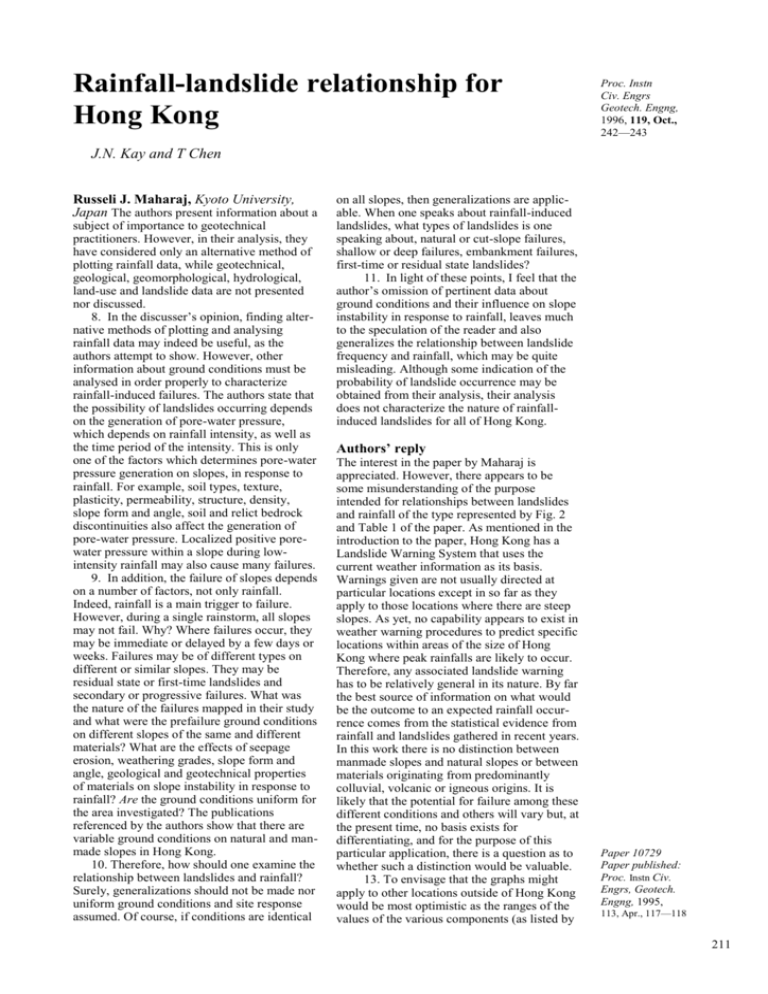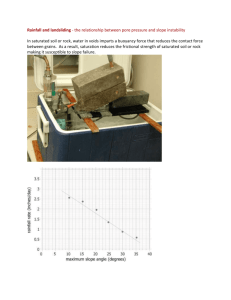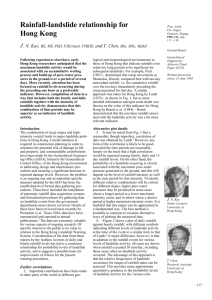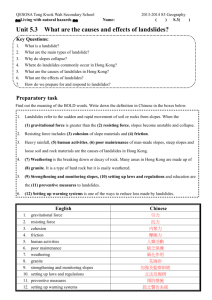Discussion on above paper
advertisement

Rainfall-landslide relationship for Hong Kong Proc. Instn Civ. Engrs Geotech. Engng, 1996, 119, Oct., 242—243 J.N. Kay and T Chen Russeli J. Maharaj, Kyoto University, Japan The authors present information about a subject of importance to geotechnical practitioners. However, in their analysis, they have considered only an alternative method of plotting rainfall data, while geotechnical, geological, geomorphological, hydrological, land-use and landslide data are not presented nor discussed. 8. In the discusser’s opinion, finding alternative methods of plotting and analysing rainfall data may indeed be useful, as the authors attempt to show. However, other information about ground conditions must be analysed in order properly to characterize rainfall-induced failures. The authors state that the possibility of landslides occurring depends on the generation of pore-water pressure, which depends on rainfall intensity, as well as the time period of the intensity. This is only one of the factors which determines pore-water pressure generation on slopes, in response to rainfall. For example, soil types, texture, plasticity, permeability, structure, density, slope form and angle, soil and relict bedrock discontinuities also affect the generation of pore-water pressure. Localized positive porewater pressure within a slope during lowintensity rainfall may also cause many failures. 9. In addition, the failure of slopes depends on a number of factors, not only rainfall. Indeed, rainfall is a main trigger to failure. However, during a single rainstorm, all slopes may not fail. Why? Where failures occur, they may be immediate or delayed by a few days or weeks. Failures may be of different types on different or similar slopes. They may be residual state or first-time landslides and secondary or progressive failures. What was the nature of the failures mapped in their study and what were the prefailure ground conditions on different slopes of the same and different materials? What are the effects of seepage erosion, weathering grades, slope form and angle, geological and geotechnical properties of materials on slope instability in response to rainfall? Are the ground conditions uniform for the area investigated? The publications referenced by the authors show that there are variable ground conditions on natural and manmade slopes in Hong Kong. 10. Therefore, how should one examine the relationship between landslides and rainfall? Surely, generalizations should not be made nor uniform ground conditions and site response assumed. Of course, if conditions are identical on all slopes, then generalizations are applicable. When one speaks about rainfall-induced landslides, what types of landslides is one speaking about, natural or cut-slope failures, shallow or deep failures, embankment failures, first-time or residual state landslides? 11. In light of these points, I feel that the author’s omission of pertinent data about ground conditions and their influence on slope instability in response to rainfall, leaves much to the speculation of the reader and also generalizes the relationship between landslide frequency and rainfall, which may be quite misleading. Although some indication of the probability of landslide occurrence may be obtained from their analysis, their analysis does not characterize the nature of rainfallinduced landslides for all of Hong Kong. Authors’ reply The interest in the paper by Maharaj is appreciated. However, there appears to be some misunderstanding of the purpose intended for relationships between landslides and rainfall of the type represented by Fig. 2 and Table 1 of the paper. As mentioned in the introduction to the paper, Hong Kong has a Landslide Warning System that uses the current weather information as its basis. Warnings given are not usually directed at particular locations except in so far as they apply to those locations where there are steep slopes. As yet, no capability appears to exist in weather warning procedures to predict specific locations within areas of the size of Hong Kong where peak rainfalls are likely to occur. Therefore, any associated landslide warning has to be relatively general in its nature. By far the best source of information on what would be the outcome to an expected rainfall occurrence comes from the statistical evidence from rainfall and landslides gathered in recent years. In this work there is no distinction between manmade slopes and natural slopes or between materials originating from predominantly colluvial, volcanic or igneous origins. It is likely that the potential for failure among these different conditions and others will vary but, at the present time, no basis exists for differentiating, and for the purpose of this particular application, there is a question as to whether such a distinction would be valuable. 13. To envisage that the graphs might apply to other locations outside of Hong Kong would be most optimistic as the ranges of the values of the various components (as listed by Paper 10729 Paper published: Proc. Instn Civ. Engrs, Geotech. Engng, 1995, 113, Apr., 117—118 211 Maharaj) that control slope stability are unlikely to be duplicated. There is no suggestion that the results might be applicable elsewhere. 14. As to how the results might be applied to specific sites in Hong Kong, the authors have also made no recommendation. Extreme levels of rainfall are critical for slope performance and others have made proposals for construction of flow nets to determine pore pressure distributions based on return period precipitation and infiltration rates for Hong Kong conditions. It has been suggested that these might take advantage of such methods as electric analogue, finite difference and finite element techniques. However, for practical purposes, the levels of uncertainty associated with the required assumptions for these methods place serious limitations on their value. In spite of the continuing emergence of ‘improved’ slope stability computer programs, these methods are unable to account for poor levels of prediction of (among other things) the critical pore-water pressure conditions. It is doubtful, therefore, whether any rational method has yet been found for reasonably interpreting the data of the type under discussion for inclusion in slope stability analysis in Hong Kong. 15. Maharaj has suggested extension of the statistical analysis type of approach to include a wide range of variables as a means for improving design and analysis methods. The data presently available are not sufficient for this purpose. As it happens, recent tragic events in Hong Kong have led to the availability of large amounts of government funding for improvement in slope engineering procedures. Some allocation of these funds to research that would include an emphasis on statistical analyses to improve assessment of slopes would be extremely valuable. 243 243








